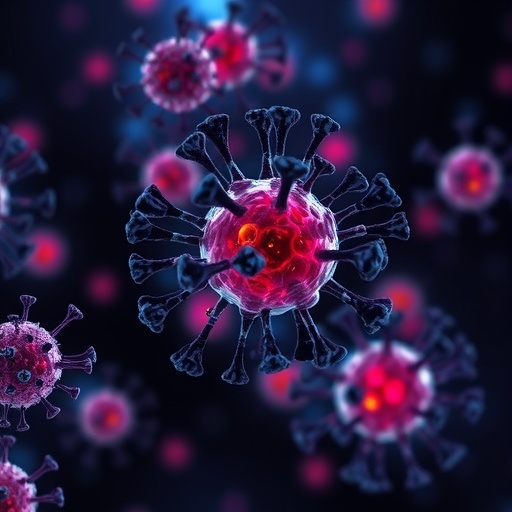In a groundbreaking investigation into pediatric liver cancer, researchers from the Princess Máxima Center and UMC Utrecht have uncovered an unexpected abundance of myeloid immune cells within hepatoblastoma tumors. This revelation challenges previous assumptions about the immunological landscape of these tumors and opens novel pathways for therapeutic intervention, especially in the realm of immunotherapy for children.
Hepatoblastoma represents the most prevalent liver malignancy in children, arising when immature hepatic cells arrest in an undifferentiated state and begin unchecked proliferation. Current treatments typically involve aggressive chemotherapy regimens combined with surgical resection, and in severe cases, even liver transplantation. Despite these approaches, outcomes remain variable, and there is an acute demand for innovative treatments to improve survival rates and reduce long-term side effects.
The role of the immune system, particularly immune cells infiltrating tumors, has become a focal point in adult oncology, where immunotherapies have revolutionized treatment paradigms. However, the immune milieu in pediatric cancers like hepatoblastoma remains poorly characterized, limiting the application of immune-targeted therapies in this vulnerable population. Recognizing this gap, the collaborative research team embarked on an in-depth study to decipher the immune cell composition within hepatoblastoma tissue.
Using advanced imaging mass cytometry, a cutting-edge technique that provides multiplexed spatial profiling of proteins within tissue at subcellular resolution, the researchers meticulously mapped immune subsets in tumor biopsies. Spatial omics technology enabled them to not only identify cell types accurately but also pinpoint their precise localization within the tumor microenvironment, offering insights into cellular interactions and functional niches.
Contrary to expectations founded on adult cancer immunology, these pediatric liver tumors exhibited a conspicuous scarcity of T lymphocytes—cells that typically mediate adaptive immune responses and are central to many existing immunotherapies. This finding suggests that hepatoblastoma in children may not respond favorably to treatments designed to activate T cells, underscoring the necessity to explore alternative immune targets.
In a striking discovery, myeloid cells—a distinct class of immune cells encompassing macrophages, monocytes, and dendritic cells—were found to predominate within the tumor landscape. These cells possess innate immune functions and can modulate inflammation, antigen presentation, and tissue remodeling. Their prominence in hepatoblastoma reveals a previously underappreciated immunological axis that could be leveraged for therapeutic gain.
Moreover, the study observed that chemotherapy administered prior to tissue sampling appeared to augment the infiltration of myeloid cells in tumors. This potentiation hints at a synergistic interplay where conventional treatments could prime the tumor microenvironment, enhancing the efficacy of subsequent immunomodulatory interventions targeting myeloid populations.
Harnessing myeloid cells for immunotherapy is an emerging frontier, propelled by their capacity to influence tumor immunity either by promoting anti-tumor responses or, conversely, by fostering immunosuppression. By dissecting the molecular signatures and checkpoint expression on these myeloid infiltrates, the researchers aim to identify actionable targets that can shift the balance toward tumor eradication.
This research exemplifies the power of combining clinical expertise with sophisticated spatial and molecular techniques. The teams from Utrecht and the Princess Máxima Center synergize spatial omics proficiency and hepatoblastoma molecular biology to generate a comprehensive immune atlas, crucial for tailoring pediatric-specific immunotherapies rather than extrapolating from adult cancer models.
While the findings are promising, the path to translating them into safe and effective treatments demands further exploration. Ongoing efforts in adult oncology assessing myeloid cell-targeted immunotherapies provide valuable knowledge, yet pediatric tumors may harbor unique immune dynamics requiring dedicated investigation.
The study also underscores the importance of mapping the immune contexture of childhood tumors broadly, as immunotherapy landscapes can differ markedly by tumor type and age group. Personalized approaches based on detailed immune profiling hold the greatest promise to improve outcomes for young patients with cancer.
This pioneering work was supported through a Boost Grant from UMC Utrecht’s Cancer Research Priority Program, TKI-Health Holland’s TumMyTOF project, and philanthropic foundations including the Kinderen Kankervrij Foundation (KiKa) and the Kus van Kiki Foundation via the Prinses Máxima Centrum Foundation. Such collaborative funding underscores the collective commitment to advancing childhood cancer research.
Situated within Utrecht Science Park, a vibrant nexus of over 1,200 researchers affiliated with institutions such as UMC Utrecht, Utrecht University, the Hubrecht Institute, and the Princess Máxima Center comprise Utrecht Cancer. This multidisciplinary consortium accelerates transformative research and clinical translation, with the ultimate goal of enhancing survival and life quality for those affected by cancer.
The elucidation of myeloid cells as dominant immune components in pediatric liver tumors signals a paradigm shift and compels the oncology community to rethink immunotherapeutic strategies in childhood cancers. As the field advances, this insight offers renewed hope for developing innovative, tailored treatments that could dramatically improve prognoses for children with hepatoblastoma.
Subject of Research: Human tissue samples
Article Title: High-plex imaging of hepatoblastoma and adjacent liver in pediatric patients reveals a predominant myeloid infiltrate expressing immune-checkpoints
News Publication Date: 13-Sep-2025
Image Credits: Vercoulen Group, UMC Utrecht
Keywords: Immunology; Data analysis; Cancer; Tumor cells; Liver tumors; Liver cancer




